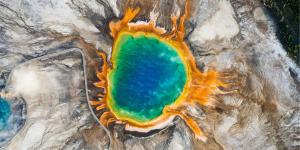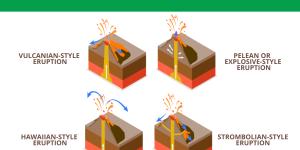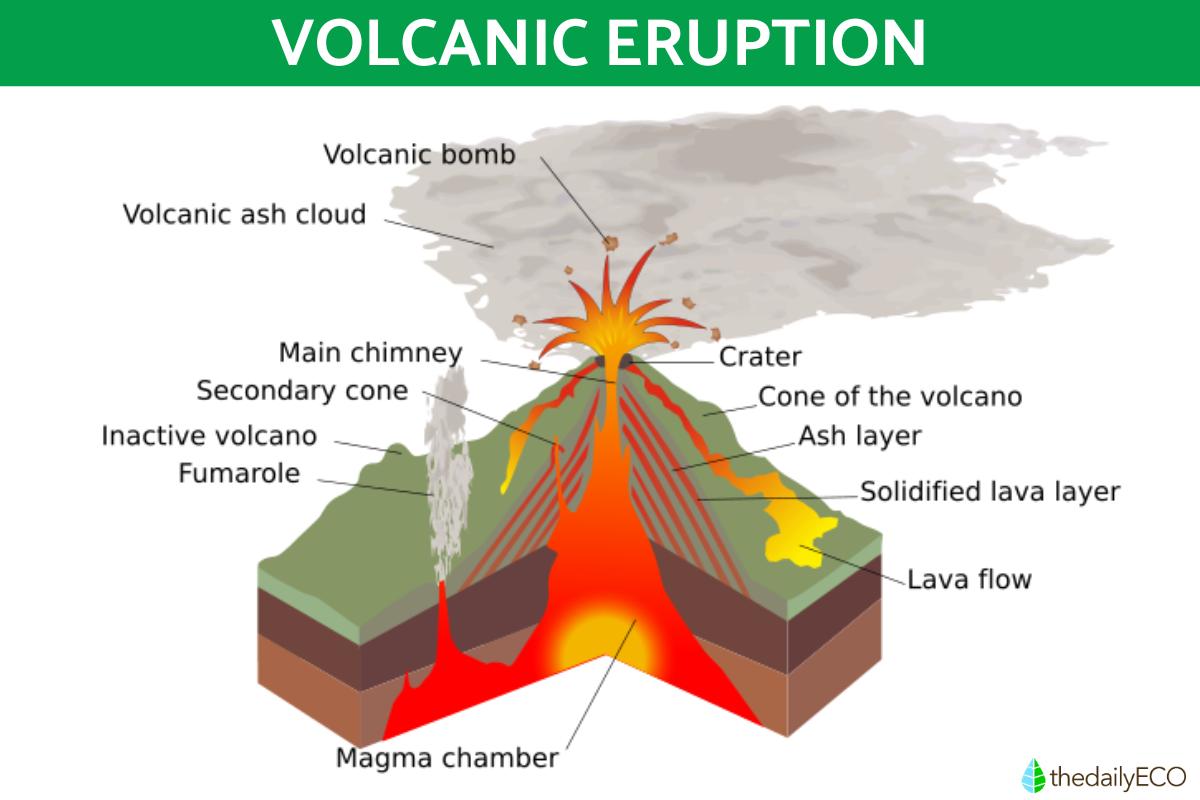What Is a Volcanic Caldera?


Volcanic calderas are complex geological structures that form after massive volcanic eruptions, leaving an indelible mark on the Earth's landscape. Named after the Spanish word for ‘cauldron’ or ‘boiler’, they are large depressions which can vary greatly in size and other characteristics. They are formed as a result of the Earth's crust collapsing when a magma chamber empties during an eruption. Discover more about the formation, types and other important data about these geological structures as thedailyECO asks what is a volcanic caldera?
What is a volcanic caldera?
A volcanic caldera is a large depression that forms in the ground after a major volcanic eruption. Volcanic craters are similar depressions, but these are smaller and present at the top of a volcano. A caldera is considerably larger and is usually caused by the collapse of magma chambers which form part of a volcano due to a large amount of magma being expelled rapidly.
Volcanic calderas are not always easy to identify. Over time they can fill with water, forming lakes. They can also become covered by vegetation which hides their form, especially when on ground level. Famous examples of volcanic calderas include the Yellowstone caldera in the United States and the Santorini caldera in Greece.
Discover the difference between lava and magma in our related guide.

How is a volcanic caldera formed?
The formation of a volcanic caldera is a complex process that occurs in several stages. We detail the process of a how a caldera is formed below:
- Magma accumulation: magma is molten rock which collects in a magma chamber beneath the Earth's surface. As a greater amount of magma is stored, the pressure inside the chamber increases.
- Volcanic eruption: when the pressure of magma reaches a critical point, it can cause an explosive volcanic eruption. This eruption can release a huge amount of magma, gases and ash towards and through the Earth's surface. You can learn more about this process in our article asking what causes a volcano to erupt?
- Emptying of the magma chamber: the massive eruption expels most of the magma that was stored in the magma chamber, leaving a vacuum or a significant reduction in pressure in the underground space.
- Collapse of the magma chamber roof: without the support of the magma that held the underground structure together, the magma chamber roof collapses under its own weight. This collapse forms a large depression on the Earth's surface.
- Caldera formation: it is this collapse which creates a caldera, a broad, usually circular depression that can vary in size from a a few miles to tens of miles in diameter.
You can see where the magma chamber is placed before a caldera is formed in the diagram below:

Types of volcanic calderas
Although the process presented above describes the general caldera formation, this process can differ to certain degrees. Doing so leads to the following types of calderas:
Collapse caldera
Collapse calderas are the most common type of volcanic caldera overall. They are formed when the empty magma chamber collapses after a massive eruption. This type of caldera is characterized by a circular or elliptical shape which can vary in size. This largely depends on the magnitude of the eruption and the volume of magma expelled. A famous example is the Crater Lake caldera in Oregon, USA, which was formed after a gigantic eruption about 7,700 years ago.
Resurgent calderas
Resurgent calderas are those where magma begins to build up again in the magma chamber after the initial collapse. This pressure can cause the floor of the caldera to rise, creating a domed structure in the center. The Valles Caldera in New Mexico, USA, is an example of a resurgent caldera. The uplift of the floor is visible in the formation of a central dome.
Subsidence calderas
Subsidence calderas are formed by the slow sinking of the Earth's surface into a gradually emptying magma chamber. This type of caldera is not associated with a single explosive eruption, but with a gradual process of loss of magmatic support. Subsidence calderas are often found in regions with sustained and prolonged volcanic activity, such as the volcanic islands of Hawaii.
Explosion calderas
This type of caldera is caused by an extremely violent volcanic explosion that releases a large amount of energy in a short period of time. The explosion is so powerful that the resulting crater is much larger and deeper than a typical volcanic crater. Explosion calderas are less common and are usually associated with volcanic eruptions with high concentrations of volatile gases and highly viscous magma. An example is the Mount Tambora caldera in Indonesia, which was formed after the catastrophic 1815 eruption, one of the most powerful in recorded history.
Phreatic calderas
Also known as hypothermic calderas, phreatic calderas are those that form in areas with high geothermal activity, but without the presence of a deep magma chamber. Instead, these calderas form near the surface where the rocks are more fragile and susceptible to collapse by thermal activity. These calderas tend to be shallower and are more associated with hydrothermal phenomena, such as the emission of geysers and hot springs. An example of a shallow caldera is the La Garita Caldera in Colorado, USA, which was formed by an extremely voluminous eruption in a region of highly fractured rock.

Examples of famous volcanic calderas
In explaining the types of calderas above, we have used some of the most recognizable as examples. Here we provide more information on examples of calderas around the world:
Yellowstone Caldera
The Yellowstone Caldera is located in Yellowstone National Park in the United States. It is one of the largest and best-known volcanic calderas in the world. Formed approximately 640,000 years ago after one of the largest volcanic eruptions in geological history, this caldera measures about miles in length and 35 miles in width. Yellowstone is a type of supervolcano, meaning that its eruption released an extraordinary amount of magma. The caldera is a geothermally active region, famous for its geysers, hot springs and continuous seismic activity, making it a site of great scientific and tourist interest.
Santorini caldera
The Santorini volcanic caldera is located in the Aegean Sea in Greece and was formed around 3,600 years ago following a catastrophic eruption that devastated the ancient Minoan civilization. This eruption was one of the most powerful in history and resulted in the collapse of the central volcano, creating a caldera that is now partially submerged in the sea. The present shape of the island of Santorini, with its iconic central lagoon surrounded by high cliffs, is a result of this caldera.
Learn about what are submarine volcanoes in our related guide.
Crater Lake caldera
Crater Lake is located in the American state of Oregon. It is a caldera that was formed about 7,700 years ago after the colossal eruption of the Mount Mazama volcano. The eruption emptied the magma chamber of the volcano, causing the ground to collapse and the formation of a caldera approximately 5 by 6 miles in diameter. Over time, the caldera filled with water, creating Crater Lake. This lake is known for its deep blue color and extraordinary clarity.
Ngorongoro Crater
Despite being known as the Ngorongoro Crater, this is actually an example of a caldera, this time located in Tanzania. In fact, it is one of the largest and best-preserved calderas in the world, although its origin is not related to an explosive eruption. Formed approximately 2 to 3 million years ago, Ngorongoro is the result of the collapse of an ancient volcano. With a diameter of about 12 miles and a depth of around 2000 ft, the Ngorongoro Caldera is home to a diverse ecosystem that includes a wide variety of wildlife. This makes it an important destination for safaris and ecological studies. It is also a UNESCO World Heritage Site.
Aso caldera
The Aso caldera is located on the island of Kyushu in Japan. It is one of the most active volcanic calderas in the world. Formed by a series of massive eruptions about 300,000 years ago, the Aso caldera is one of the largest on the planet, with a diameter of approximately 15 miles. Several active volcanoes are located within the caldera, with Mount Nakadake being the most prominent and which erupts most frequently. The region is known for its constant volcanic activity and for being an important tourist and agricultural site in Japan.
Learn about how volcanoes can create other types of geographical feature with our article on what is a mid-ocean ridge?
If you want to read similar articles to What Is a Volcanic Caldera?, we recommend you visit our Facts about nature category.
- Volcanic calderas. Climbing Volcanoes.
https://www.subiendovolcanes.com/p/calderas-volcanicas.html - Adelina Geyer Traver. (2007). "Dynamics and structural evolution of collapse calderas: A comparison between field evidence, analogue and mathematical models". University of Barcelona.
https://diposit.ub.edu/dspace/bitstream/2445/34909/1/00.AGT_PREVIOUS_RESUMEN.pdf - Volcanoes: what they are, types, parts and characteristic eruptions. Easy Geotechnics.
https://geotecniafacil.com/tipos-volcanes/ - J. Martínez, I. Menéndez, D. Casas. Volcanic landforms: The calderas.
https://accedacris.ulpgc.es/bitstream/10553/1197/1/4365.pdf








